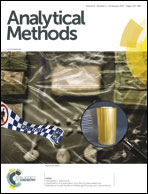Graphene oxide–alizarin yellow R–magnetic chitosan nanocomposite: a selective and efficient sorbent for sub-trace determination of aluminum in water samples
Abstract
A selective, fast and inexpensive magnetic dispersive solid phase extraction (MDSPE) based on a graphene oxide–alizarin yellow R–magnetic chitosan nanocomposite (GO–AYR–MC) was developed for the determination of aluminum in water samples. The sorbent was characterized by Fourier-transform infrared spectroscopy (FT-IR), scanning electron microscopy (SEM) and energy dispersive X-ray spectroscopy (EDX). The results showed that alizarin yellow R was successfully attached onto the surface of graphene oxide (GO–AYR) and the graphene sheets were crosslinked with the magnetic chitosan. Various parameters affecting the aluminum extraction, such as pH of the sample solution, sorbent amount, adsorption and desorption time, and concentration and volume of desorption eluent were optimized by design of experiment (DOE) and response surface methodology (RSM). Under optimum conditions, a calibration curve within the range of 0.01 to 2.5 μg mL−1, with a determination coefficient of 0.9997, was achieved. The pre-concentration factor and limit of detection (LOD) were found to be 50 and 5.0 ng mL−1, respectively. The maximum adsorption capacity of the sorbent was calculated to be 11.6 mg g−1. The repeatability and reproducibility for five replicate measurements of aluminum at the concentration of 50 ng L−1 were 2.6% and 8.0%, respectively. Finally, the developed method, followed by flame atomic absorption spectroscopy (FAAS), was successfully applied for the selective determination of trace amounts of aluminum in water samples and good relative recoveries were obtained within the range of 93.5 to 108%.


 Please wait while we load your content...
Please wait while we load your content...